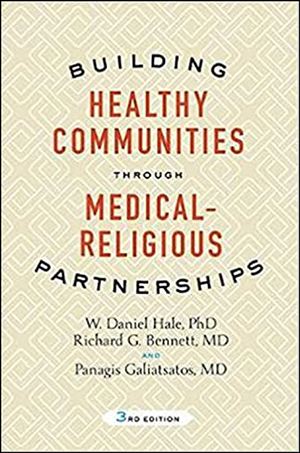
BUILDING HEALTHY COMMUNITIES THROUGH MEDICAL-RELIGIOUS PARTNERSHIPS
W. Daniel Hale, PhD; Richard Bennett, MD; and Panagis Galiatsatos, MD
Johns Hopkins University Press, Baltimore, 3rd Edition 2018, 280 pgs.
JULIE TROCCHIO, BSN, MS
Medical-Religious Partnerships Collaborate to Improve Health
As if we hadn't known, COVID-19 revealed that the oldest among us are the most vulnerable. Seniors with chronic illness got sick, very sick and died from COVID. Seniors living in nursing homes represented about 40% of U.S. deaths from the virus. Their lives were in jeopardy, the quality of their lives suffered.
Did it have to be this way? Can we better serve our seniors with chronic illness? Can we offer alternatives to nursing homes? Can we help caregivers keep their loved ones at home?
Building Healthy Communities through Medical-Religious Partnerships is a practical book by a psychologist and two physicians, with commentaries by a chaplain, intern and pastor, that offers possible answers.
Medical Religious Partnerships describes relationships between heath systems and faith congregations formed to meet many of the difficult challenges of an aging society. It is rich with program examples and resources for providing services to seniors and their caregivers.
In the foreword, Patricia Fosarelli, MD, DMin, says that in her experience, "people often perish before their time because of lack of accurate information about potential and existing health threats, or their lack of trust in medical institutions …" This book addresses both problems: how to bring important health and resource information to those who need it and how to have that information come from trusted sources that are deeply rooted in the community — religious congregations.
In recent years, we have seen health care change from focusing mostly on acute problems to caring for chronic illnesses. This means individuals have more of a role in and responsibility for their own care. But patients, especially seniors, need help to learn what they need to know about their medical conditions and how to manage their health. Health care organizations and their clinicians cannot do this by themselves. This book suggests that faith communities and those in health care working together can provide that help.
Why should congregations of people of faith get involved in health education? The authors say that faith communities (parishes, synagogues, mosques) have tremendous potential to meet health needs of seniors because they have the community resources and communication networks that hospitals and other providers don't necessarily have. "No community institutions are better suited to serve as partners for hospitals … Congregations can be inviting, encouraging, and informing, empowering people to take proactive steps in the care of their bodies, minds and souls."
Large numbers of older adults, many with chronic conditions, gather regularly with their faith congregation. Leaders in these environments know their congregations' traditions and values and have the trust of their members. Most have excellent facilities, parking, and equipment for programs and human capital such as retirees and other potential volunteers.
The book opens with a story about a Presbyterian pastor at Westminster By-The-Sea Church in Daytona Beach, Dr. Jeffery Sumner, who discovered he had diabetes at a health screening at his parish. After his diagnosis was confirmed, he became a regular participant of his church's Body Mind and Soul program, a collaboration with a local hospital. Through classes, he learned about how harmful diabetes could be if not controlled and how to manage it. He found the health seminars and discussions with health professionals and members of the congregation to have a spirit of openness and trust.
Similar programs offer classes on identifying warning signs and managing heart disease, stroke, cancer, diabetes, depression, dementia. Sessions also might cover managing medications, home safety and immunizations.
Building Healthy Communities through Medical-Religious Partnerships describes several programs in the Baltimore area with the Johns Hopkins Hospital and its physicians. At the Southern Baptist Church guest lecturers speak about health from the pulpit, volunteers take blood pressures in the fellowship hall after services, and classes and screenings are provided in a nearby affordable housing project.
At Baltimore's Sacred Heart of Jesus Catholic Church — known to members of the growing Latino community as Sagrado Corazon de Jesus — the weekly bulletin has information about hypertension, diabetes and other health topics. Dr. Gerardo Lopez-Mena, a second-year resident at Hopkins who was seeing patients in the emergency room who did not know how to manage their medical conditions, began teaching Spanish-language health education classes.
The city's Beth El Congregation's "Soul Center" has events for caregivers, including workshops, seminars and time to meet with others, demonstrating how these programs can offer family caregivers a safe environment for sharing concerns. The events give practical advice on getting the most out of medical appointments, keeping track of medications and watching for side effects.
The book suggests topics and content that medical-religious partnerships can bring to congregations, including basic information on coronary artery disease, hypertension, lung disease, diabetes, kidney disease, cancer, child and adolescent health, vaccinations, advance directives, depression and dementia. It also features information that can be presented about modifying risk factors, communicating with health providers, managing medications, and preventing accidents and falls. An extensive resource section offers suggestions for tapping community resources and information available from national organizations.
JULIE TROCCHIO, BSN, MS, is senior director of community benefit and continuing care for the Catholic Health Association, Washington, D.C.
ADDITIONAL INFORMATION
Joe Eaton, "Who's to Blame for the 100,000 COVID Dead in Long-Term Care?," AARP, Dec. 3, 2020,
https://www.aarp.org/caregiving/health/info-2020/covid-19-nursing-homes-who-is-to-blame.html.
Johns Hopkins has created a supplemental website to the book. This is a practical guide for leaders of faith congregations and health care providers looking for solutions for older people and their caregivers. The site includes downloadable handouts and PowerPoint slides, https://www.hopkinsmedicine.org/about/community_health/johns-hopkins-bayview/services/healthy_community_partnership/building_healthy_communities/index.html.